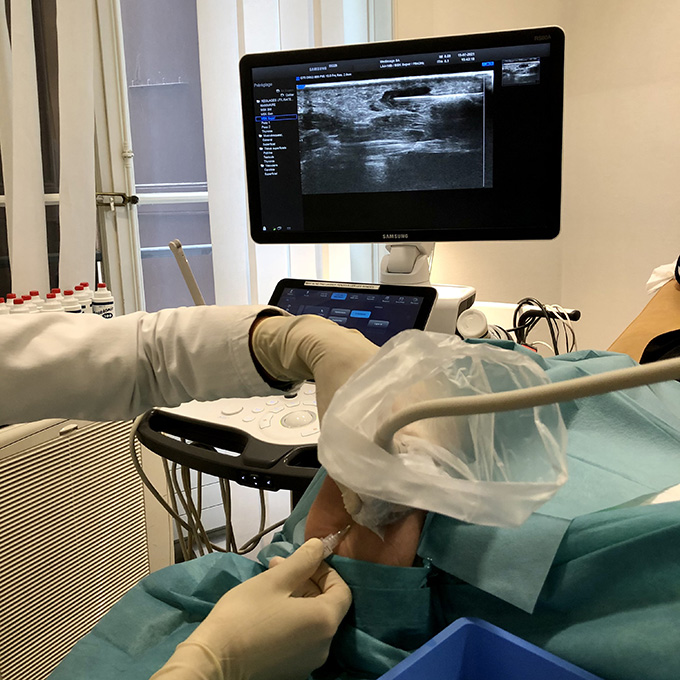
The purpose of extra-articular infiltration
There are different soft tissue conditions that mainly affect the muscles, tendons or ligaments. Often caused by excessive or incorrect use of these tissues, soft tissue pathologies are generally characterised by persistent pain and limitations in mobility and dexterity.
These muscle, ligament or tendon disorders are most often caused by injuries that can lead to work incapacity or the cessation of sporting activities. They are often located near joints such as the shoulder, elbow, pelvis, knee or heel.
Localised injections are common practice to treat these rheumatological conditions and reduce suffering in the long term.
Let’s look together at everything you need to know about this radiological procedure.
Non-tumour soft tissue pathologies
Soft tissue pathology is a term used to designate the various disorders affecting the non-osseous structures of the musculoskeletal system, i.e. structures enabling movement. This does not include rheumatic damage to the joints and articular cartilages, which are the cause of arthritis or osteoarthritis. This is then referred to as tendinitis, sprains, faceitis, epicondylitis, bursitis, etc.
These musculoskeletal disorders are among the most common conditions in Switzerland.
They generally result in often chronic pain in the muscles, tendons, ligaments, bursa (pockets containing synovial fluid to reduce friction), connective tissue or fat. The pain can be generalised or localised as is the case with tennis elbow or inflammation of the tendon sheaths. A sensation of heat can also be felt due to inflammation. These symptoms usually occur when resting.
To date, there is no single cause. However, these are often caused by age, an immune system disorder, abnormalities in the joints and repeated micro traumas due to the repetition of certain movements.
What is extra-articular infiltration?
There is a wide range of therapeutic methods such as physical therapies or drug treatments used as first-line treatment. However, when these prove to be ineffective, infiltration can be used to relieve the patient and improve their quality of life. It is common practice in the treatment of rheumatological conditions and is part of the patient’s overall therapeutic management. Its purpose is to inject a small amount of a specific drug into the area to be treated. The product injected is usually an anti-inflammatory belonging to the corticosteroid family.
Conditions affected by this type of infiltration
- Localised conditions
- in the hand (carpal tunnel syndrome, tenosynovitis, trigger finger, etc.)
- in the elbow (tennis elbow, epicondylitis, etc.)
- in the shoulder (inflammation following calcification of the shoulder, rotator cuff injury, bursitis, tendinitis, etc.)
- in the heel (calcaneal spur, aponeurosis, etc.)
- Fibromyalgia syndrome
- generalised soft tissue pain
- chronic diffuse muscle pain around the joints and in the spine
Why perform this medical procedure in the radiology department?
Some structures are complex and need to be explored under ultrasound or X-ray guidance. The images from the method used, which is chosen using software, will enable the radiological procedure to be performed with more precision. The objective is to directly inject the active ingredient into the painful area and to limit its diffusion to the whole body, as is the case when taking oral medication.
How does the extra-articular infiltration work?
This is an outpatient procedure. The patient is placed in a lying or sitting position. The radiologist, assisted by a medical imaging technician, will first perform an ultrasound or X-ray to target the area to be injected. Once the images have been observed, they will locally disinfect the region under rigorous aseptic conditions. Local anaesthetic will sometimes be used.
Then, using X-ray or ultrasound, the radiologist will inject the anti-inflammatory product delicately and precisely. This injection is no more painful than a blood test.
This is a quick procedure that only takes about 20 minutes. This makes it possible to resume daily activities while avoiding straining the treated area.
Sometimes the inflammation of the area is due to excess fluid around the joints. This means that the area can simply be drained, or it can be drained prior to infiltration.
What are the advantages of infiltration?
The effects of the extra-articular infiltration will be felt 5 to 10 days after the procedure. Using this technical radiological procedure, which improves the quality of life of patients, it becomes possible to resume activities, even sports – in agreement with the attending physician.
What complications are linked to infiltration?
Complications are extremely rare because the preventive methods created by the aseptic measures can significantly reduce the risks.
Want to learn more about soft tissue infiltration?
If you would like more information on extra-articular infiltration or would like to make an appointment for an examination, do not hesitate to contact us.
Learn more about pudendal infiltration, osteoarticular infiltration, foraminal spinal infiltration, epidural lumbar infiltration or hyaluronic acid infiltrations.
Learn more about the other examinations available at the Medimage centre: radiography and radiology in Geneva, MRI in Geneva (Magnetic Resonance Imaging), CT scan, cardiac imaging, mammogram in Geneva, ultrasound in Geneva, elastography, biopsy in Geneva, infiltrations in Geneva, PRP infiltrations, dental panoramic or mineralometry.
Take a look at our medical team and our radiologists.
